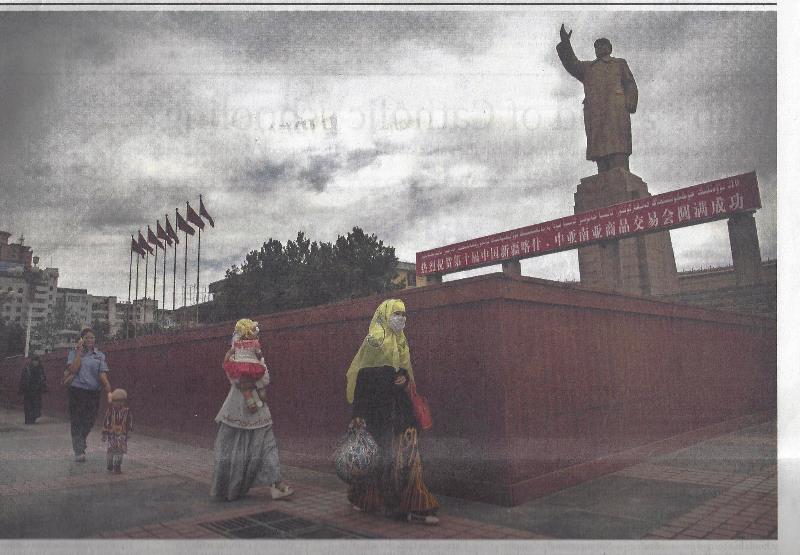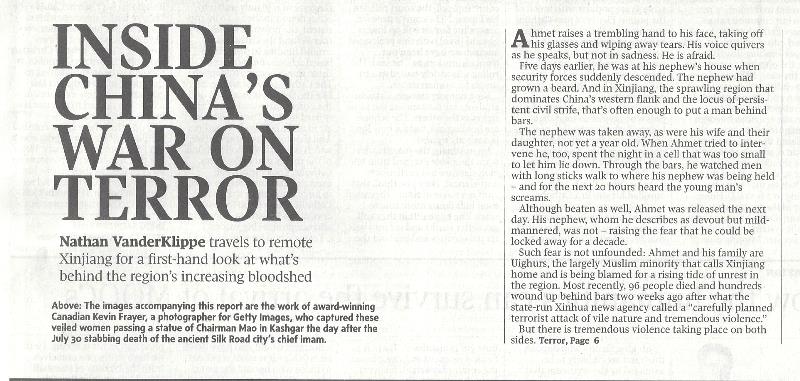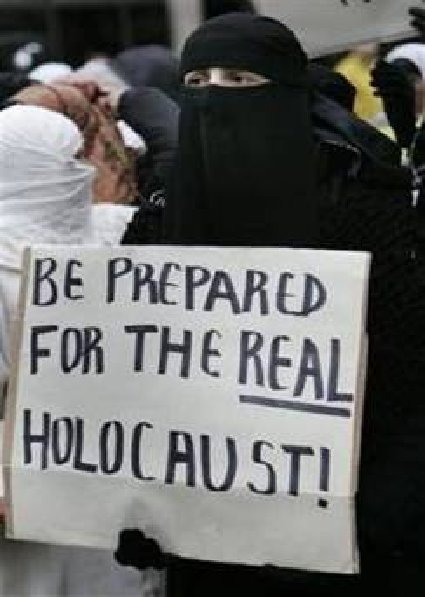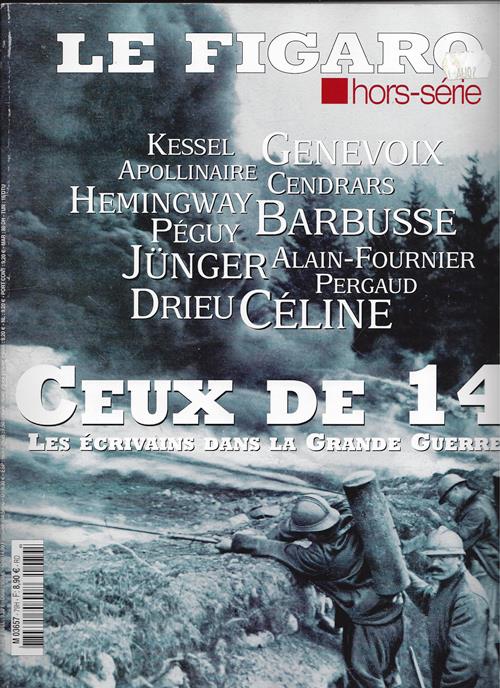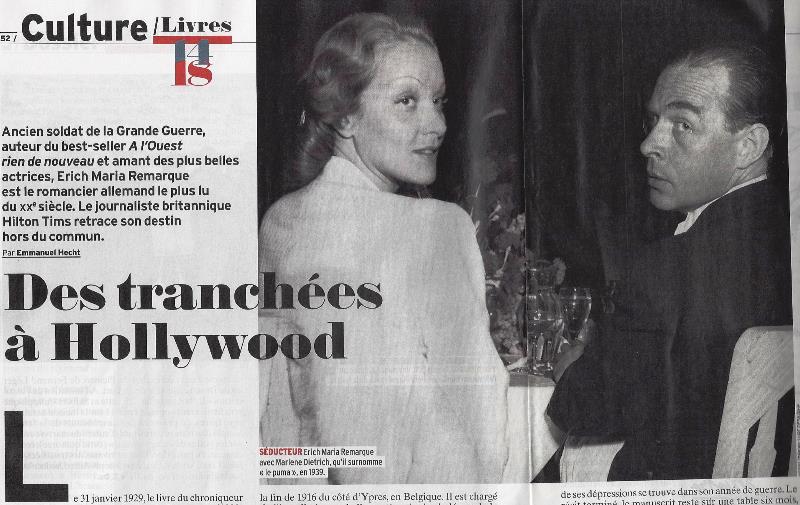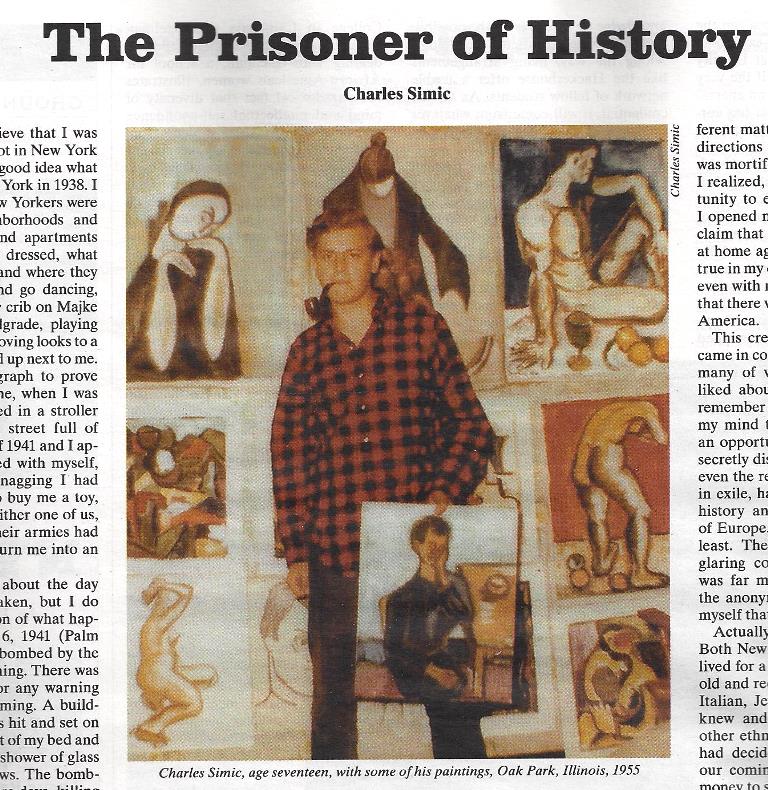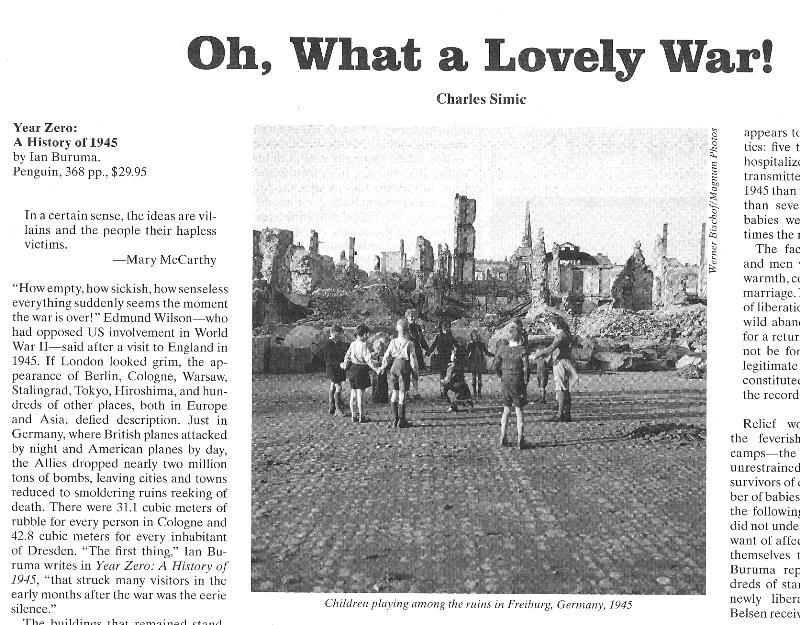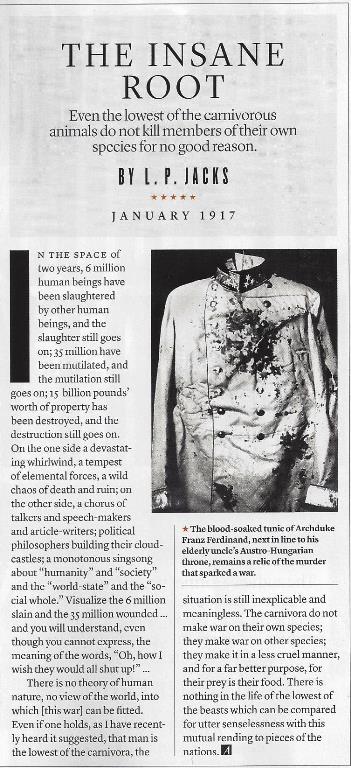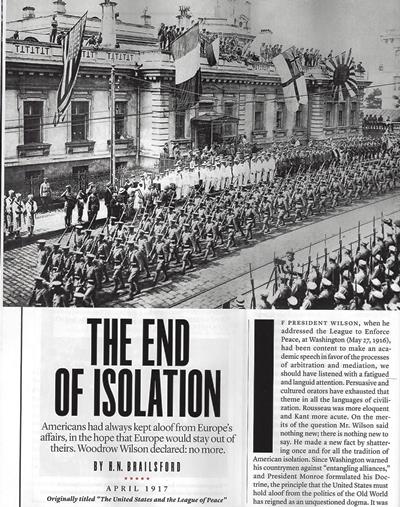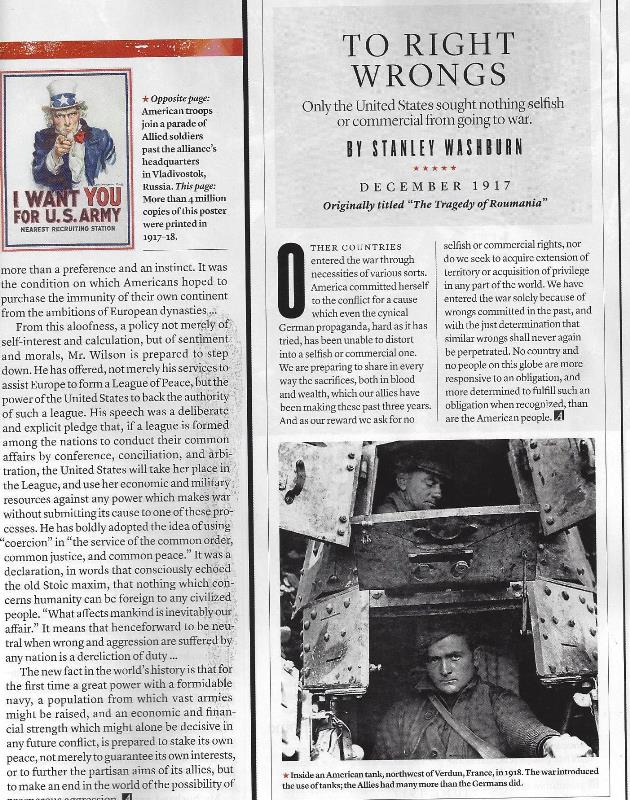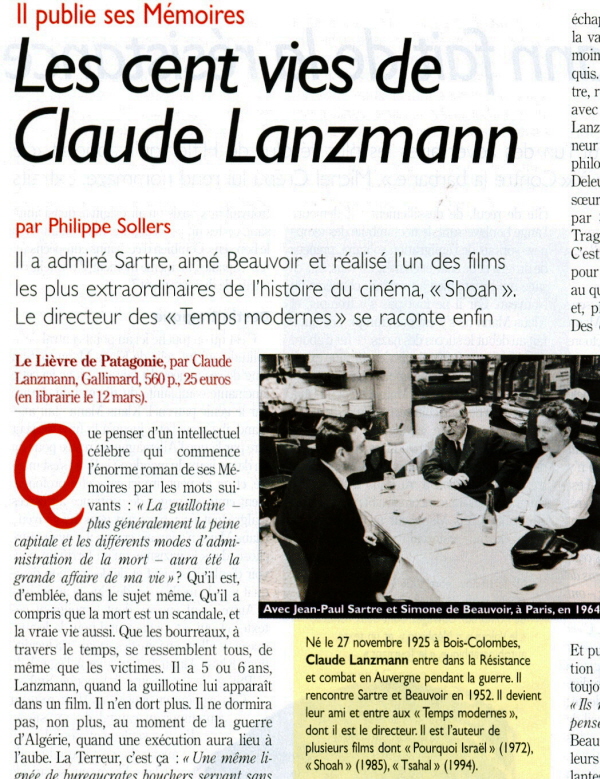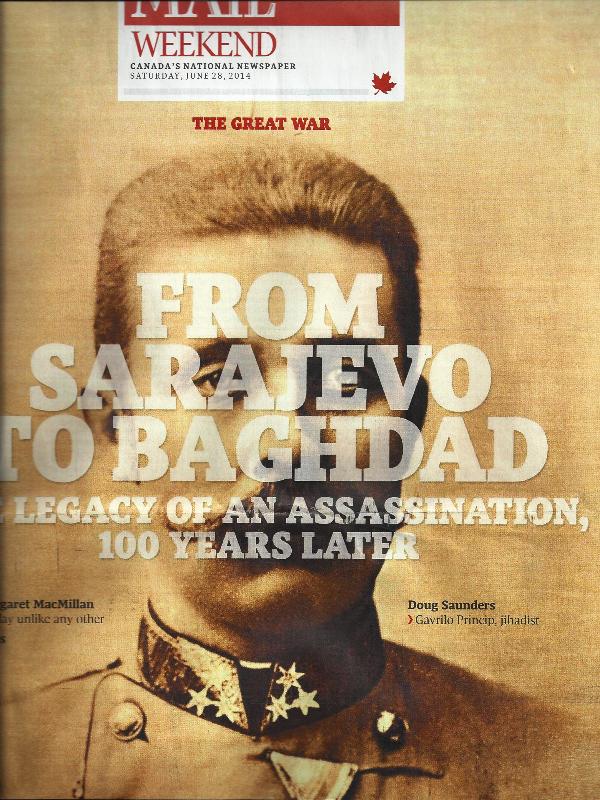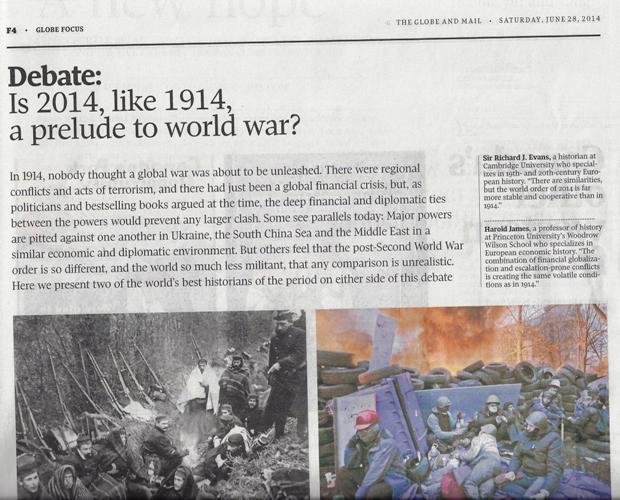|
|
Album
|
Hình chụp
trong cuộc biểu diễn lực lượng của Hồi Giáo ở Luân Đôn,
Pictures
from London:
These
pictures are of Muslims marching through the STREETS OF LONDON during
their
recent 'Religion of Peace' Demonstration.
Tờ Globe and
Mail, Toronto, đã coi năm 1914 mở ra cuộc Thế Chiến, có gì tương tự với
2014
Is 2014,
like 1014, a prelude to world war?
Liệu 2014, như 1914, con
chim "báo bão"?
Thằng bé,
the boy, làm thịt Archduke và mở cánh cửa cuộc chiến toàn cầu [The
Globe and
Mail]
Mít, khùng,
như GCC, làm sao mà không nghĩ đến cú Văn Cao làm thịt tên “Việt Gian”
DDP, mở
ra cuộc chiến Mít lần thứ nhất?
1914-2014
Mặt Trận Miền
Tây Vưỡn Yên Tĩnh, cuốn tiểu thuyết best-seller nhất của thế kỷ!
Thua "Lỗi Buồn Chiến
Tranh" của Bảo Ninh:
Không giống như Mặt Trận Miền Tây Vẫn
Yên Tĩnh, đây là một cuốn tiểu thuyết không chỉ về chiến tranh. Một
cuốn sách về chuyện viết, về tuổi trẻ mất mát, nó còn là một câu chuyện
tình đẹp, nghẹn ngào [Lời giới thiệu của Geoff Dyer trên tờ Independence, in
lại trong bản dịch tiếng Anh của Nỗi Buồn].
Tình cờ, vớ
được số báo cũ, trong cái mớ hầm bà làng-thùng rác cuối đời, 1 bài
viết, cũng của
Simic, về, cũng cuộc chiến đó, mà ông là 1 đứa con nít, “tù nhân nằm
trong nôi”-
chữ của Thảo Trường, khi chứng kiến vụ Trần Trường –
Cái tít, “Ui cuộc
chiến mới
đẹp làm sao”, thì có thua gì câu thơ, "Đường ra trận mùa này đẹp lắm"?
Bài này cũng thật là tuyệt cú mèo, hà, hà!
NYRB Oct 10, 2013
Oh! What a Lovely War!
1914-2014
Is 2014,
like 1014, a prelude to world war?
Liệu 2014, như 1914, con
chim "báo bão"?
Thằng bé,
the boy, làm thịt Archduke và mở cánh cửa cuộc chiến toàn cầu [The
Globe and
Mail]
Mít, khùng,
như GCC, làm sao mà không nghĩ đến cú Văn Cao làm thịt tên “Việt Gian”
DDP, mở
ra cuộc chiến Mít lần thứ nhất?
Đúng là như
thế.
Bởi là vì cuộc
chiến Mít thứ nhất nổ ra, do dã tâm của VC, phải làm cỏ sạch các đảng
phái
khác, khi choàng cho chúng cái nón Việt Gian, theo Tây. Muốn như thế,
thì phải
nổ ra cuộc chiến.
Những tài liệu
Gấu mới được đọc, của tụi Tẩy, xác nhận điều này. Cuộc chiến chống Pháp
có thể
không xẩy ra, nếu Việt Minh thực tình không muốn gây chiến.
Cũng thế là
cuộc kháng chiến thần thánh chống Mẽo cứu nước: Phải làm cho cuộc chiến
nổ ra,
để đẩy cả một miền đất vào thế… Ngụy, trừ
đám nằm vùng. Cú đầu độc tù Phú Lợi, do VC phịa ra, để có cớ thành lập
MTGP, Mẽo
hoảng quá, bèn đổ quân vô!
Giả như không
có cú Phú Lợi, thì cũng phải phịa ra nó. Mẽo cũng dùng đòn này, để rút
ra khỏi
cuộc chiến Mít, khi ngụy tạo cú Vịnh Bắc Bộ.
Trong
Thế Chiến 1914, Mẽo là nước độc nhất tham
gia, không vì vị kỷ, và đó là do tổng thống Mẽo, Woodrow Wilson, muốn
như thế!
No
More Isolation!
[Báo Atlantic, số đặc biệt về
WWI, July, 2014]
1914-2014
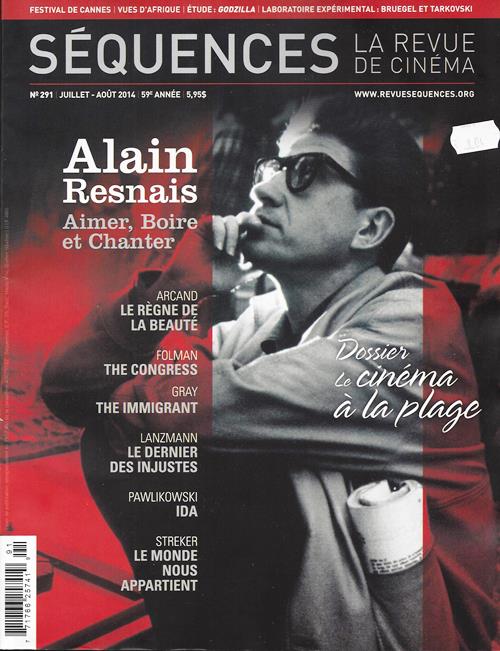
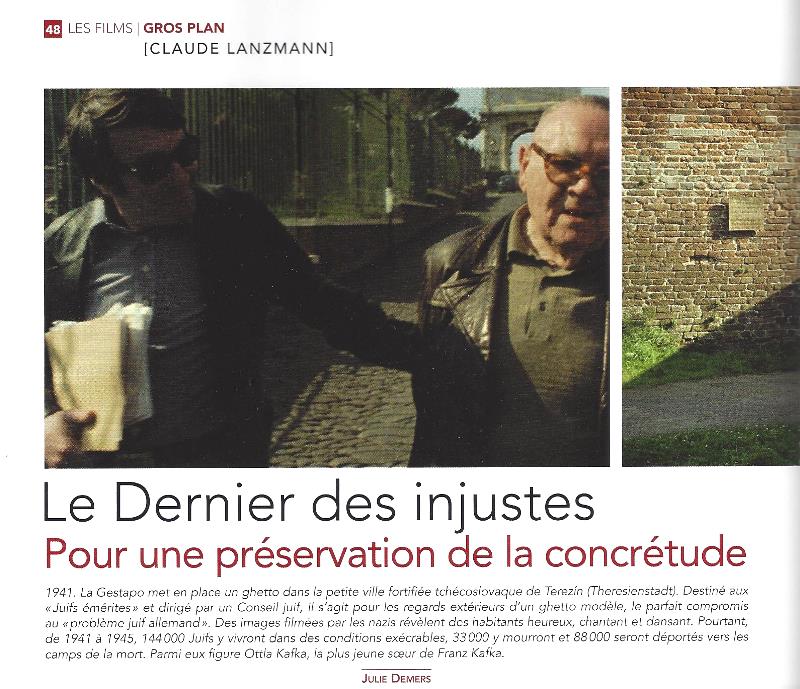
Kẻ bất trung thực cuối cùng
The
Defense of a Jewish Collaborator
Tại sao mi sống
sót?
[Pourquoi avez-vous survécu?]
Còn mi thì
sao?
[Et vous?]
“Kẻ bất
trung thực cuối cùng”, là 1 phim đối trọng, contre-poids, với phim Lò Thiêu, Shoah, cũng của Lanzmann. Tên
phim cũng là nick của nhân vật chính trong phim, 1 tên Do Thái đã từng
cộng tác
với Nazi, một trong những Trưởng Trại của một ghetto kiểu mẫu, được
thiết lập để
trình ra cho nhân loại thấy, ở tù Nazi sung sướng như thế nào.
The specter
of Hannah Arendt haunts every film Claude Lanzmann has made, beginning
with his
nine-and-a-half-hour epic Shoah, released in 1985. Arendt believed that
the
Nazi experience could be understood, and had to be, since only through
understanding can “we come to terms with, reconcile ourselves to
reality, that
is, try to be at home in the world.” This would mean reconciling
ourselves, in
some sense, even to the Holocaust. “To the extent that the rise of
totalitarian
governments is the central event in our world,” she once wrote, “to
understand
totalitarianism is not to condone anything, but to reconcile ourselves
to a
world in which these things are possible at all.”
Lanzmann
refuses to understand the Holocaust, let alone make peace with the
world that
made it possible. A short essay only three paragraphs long is his most
powerful
retort to Arendt:
All one has
to do, perhaps, is pose the question simply, and ask, “Why were the
Jews
killed?” This shows its obscenity. There is an absolute obscenity in
the
project of understanding. Not understanding was my iron law during all
the
years of preparing and directing Shoah: I held onto this refusal as the
only
ethical and workable attitude possible…. “Hier ist kein Warum”: this,
Primo
Levi tells us, was the law at Auschwitz that an SS guard taught him on
arriving
at the camp: “Here there is no why.”
Bóng
ma Hannah Arendt ám ảnh mọi phim của Claude Lanzmann, bắt đầu với sử
thi Lò Thiêu dài 9 tiếng
rưỡi, ra lò năm 1985. Arendt tin rằng
kinh nghiệm Nazi có thể hiểu được,
và sự tình phải như thế, bởi là vì, chỉ thông qua hiểu biết chúng ta
mới có thể
xoay sở được với thực tại , nghĩa là, cố “ở nhà” với thế gian, coi nó
là nhà của
mình.
Theo nghĩa đó hãy cố mà sống, ngay
cả với Lò Thiêu…
Lanzmann
đếch chịu thế, hà, hà!
Amos Oz cho
biết, khi coi phim Shoah, une
histoire orale de l’Holocauste, của đạo diễn Claude Lanzmann, một
trong những xen rất ư là bình thường, chẳng có tính điện ảnh, nhưng bám
chặt vào ký ức ông. Đó là xen, kéo dài chừng 15 phút, chiếu cảnh
Hilberg - ngồi trong căn phòng xinh xắn, tại nhà của ông, ở Vermont,
[người ta nhìn thấy, qua cửa sổ, bên ngoài cây cối, tuyết, bên trong,
những cuốn sách, ngọn đèn bàn] - giải thích cho nhà đạo diễn Claude
Lanzmann, nội dung một tài liệu đánh máy, tiếng Đức, chừng 15 dòng, gồm
những dẫy số.
Một “ordre de route”, (lệnh chuyển vận) của chuyến xe lửa số 587, do
Gestapo Berlin,
chuyển cho Sở Hoả Xa Reich, “lưu hành nội bộ”.
Một bí mật nằm ở nấc thang chót, của bộ máy giết người.
Hilberg giải thích: “Chìa khóa tâm lý của toàn thể chiến dịch, là:
không bao giờ được sử dụng những từ có ý nghĩa hoàn toàn rõ rệt. Tối
giản tối đa, chừng nào còn có thể tối giản, ý nghĩa của chiến dịch sát
nhân, đưa người tới Lò Thiêu. Ngay cả dưới mắt của chính những tên sát
nhân.”
Thú thực, trước đây, nói gì thì nói, Gấu vẫn không hiểu tới tận nguồn
cơn, tại làm sao mà lại gọi "đi tù" là "đi học tập cải tạo", tại sao
lại dùng một mỹ từ như thế, cho một từ bình thường như thế, như thế,
như thế... cho đến khi đọc Oz. (1)
Nó làm Gấu
nhớ đến cái chết dởm của mấy tên tù VC, ở trại tù Phú Lợi, mở ra cuộc
chiến Mít
lần thứ nhì, làm chết trên 3 triệu Mít, và làm tiêu luôn nước Mít.
Tuy nhiên,
nó còn làm Gấu nhớ đến bài thơ của Auden, được nhà
thơ Mẽo
Robert Hass vinh danh sau đây:
Bài thơ chấm
dứt một ngàn năm
Chính là vì,
phải tìm đủ cách ăn cướp Đàng Trong, mà lũ Bắc Kít đã rước họa Tầu Phù
vô “Đàng
Ngoài “ Chúng quên nỗi nhục nô lệ thằng Tầu 1 ngàn năm.
Bi giờ nghe
tụi chúng chống Tẫu, lèm bèm về “thoát Trung”, Gấu thấy tởm, cực tởm!
Tuy nhiên bài thơ
thần sầu này chẳng
mắc mớ gì tới ba cái chuyện nhơ bửn đó.
Nó làm nhớ đến ông anh nhà thơ, qua những
câu như:
A few
thousand will think of this day
Mad Ireland hurt you into
poetry
For poetry makes nothing
happen: it survives....
WWI
CENTENARY
On July 28th
it will be 100 years since the first world war broke out. Its
battlefields have
long since turned into centres of remembrance, destinations for school
trips.
In this photo essay, Brian Harris captures their stillness and symbolism
From
INTELLIGENT LIFE magazine, July/August 2014
One evening
last March, Brian Harris stopped his car at the side of the road near
Douaumont
in north-eastern France and walked into the forest. After about 50
yards he
came to a trench winding its way through the trees (see photo four).
He’d been
there earlier in the day, but the light had been too sharp, the shadows
cast by
the trees too deep, and children from a school party had been running
up and
down the trench, their picnic laid out nearby. But now the light was
softer,
and the woods were gloomy and quiet. “I wanted to photograph the
darkness where
that trench went,” he says. “I knew that if you dug down into that
ground you
would find bits of body. In that forest there are the remains of men.
Those
roots are feeding off men.”
He was
standing on the Verdun battlefield, one of the bloodiest of the first
world
war, which began 100 years ago this July. During ten months of fighting
in
1916, up to 976,000 French and German soldiers were killed or wounded
at
Verdun. Many of the dead were never found. “To stand in a wood and
listen to
the quiet,” Harris says, “and realise that 100 years ago, where you’re
standing, was carnage—that’s chilling.” The trench he photographed led
from
Belleville to the front line and the fort at Douaumont. “It was a
pathway to
death.” His image—haunted, sombre, terrifyingly tranquil—is his elegy.
AISNE-MARNE
AMERICAN CEMETERY, BELLEAU, FRANCE
There are
2,289 graves here, at the foot of the hill where the battle of Belleau
Wood was
fought in June 1918. When Brian Harris was there, a new watering system
was
being installed, so the grass wouldn’t be parched for the centenary. He
was
struck by the effect. “It’s emotive. If you want the water to be rain,
it’s
rain. If you want it to be tears, it’s tears”
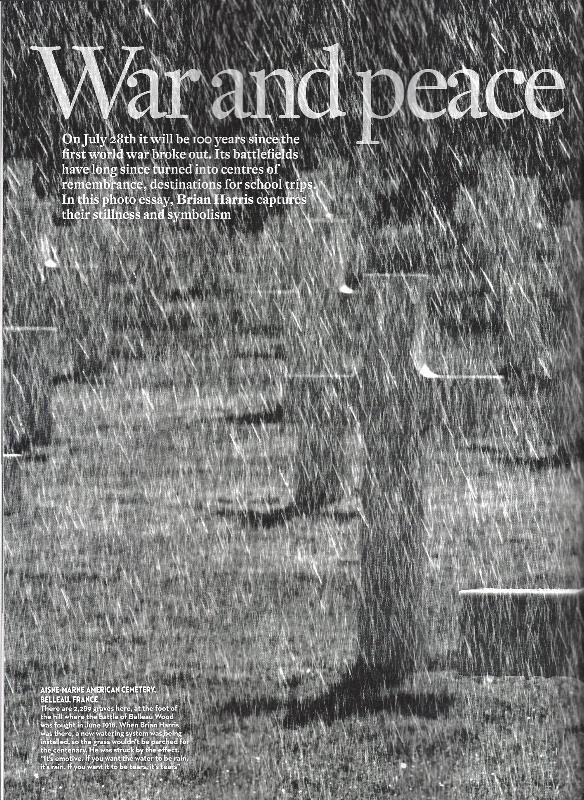
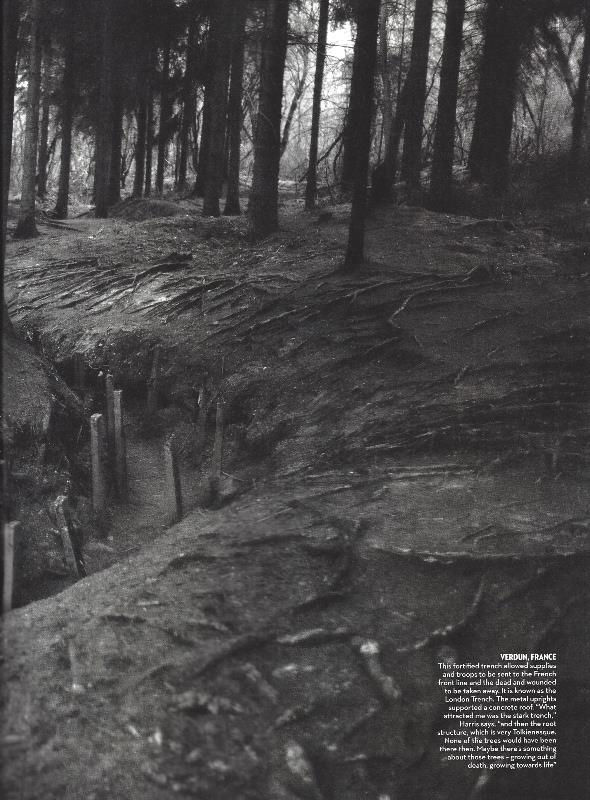
VERDUN,
FRANCE
This
fortified trench allowed supplies and troops to be sent to the French
front
line and the dead and wounded to be taken away. It is known as the
London
Trench. The metal uprights supported a concrete roof. “What attracted
me was
the stark trench,” Harris says, “and then the root structure, which is
very
Tolkienesque. None of the trees would have been there then. Maybe
there’s
something about those trees—growing out of death, growing towards life”
Liên tưởng
khùng làm GCC nhớ tới “Đường Mòn HCM”. Chỉ có khác, là, 1 con đường và
những
cây của nó, ở đây, đem đến đời sống.
Đường Mòn HCM, đem đến cái chết cho cả 1 xứ
Mít!
Intel
Life
1914-2014

 
VERDUN,
FRANCE
This
fortified trench allowed supplies and troops to be sent to the French
front
line and the dead and wounded to be taken away. It is known as the
London
Trench. The metal uprights supported a concrete roof. “What attracted
me was
the stark trench,” Harris says, “and then the root structure, which is
very
Tolkienesque. None of the trees would have been there then. Maybe
there’s
something about those trees—growing out of death, growing towards life”
1914-2014
Nó làm Gấu
nhớ đến cái chết dởm của mấy tên tù VC, ở trại tù Phú Lợi, mở ra cuộc
chiến Mít
lần thứ nhì, làm chết trên 3 triệu Mít, và làm tiêu luôn nước Mít.
Tuy nhiên,
nó còn làm Gấu nhớ đến bài thơ của Auden, được nhà
thơ Mẽo,
Robert Hass vinh danh sau đây:
Bài thơ chấm
dứt một ngàn năm
Chính là vì,
phải tìm đủ cách ăn cướp Đàng Trong, mà lũ Bắc Kít đã rước họa Tầu Phù
vô “Đàng
Ngoài “ Chúng quên nỗi nhục nô lệ thằng Tầu 1 ngàn năm.
Bi giờ nghe
tụi chúng chống Tẫu, lèm bèm về “thoát Trung”, Gấu thấy tởm, cực tởm!
Tuy nhiên bài thơ
thần sầu này chẳng
mắc mớ gì tới ba cái chuyện nhơ bửn đó.
Nó làm nhớ đến ông anh nhà thơ, qua những
câu như:
A few
thousand will think of this day
Mad Ireland hurt you into poetry
For poetry makes
nothing happen: it survives....

Although most of the pictures here were taken last
winter, they are the result of a 45-year fascination. In 1969, when he
was 16 and living in Romford in Essex, Harris went on a school trip to
Belgium. “We stayed in Blankenberge, played on the beach, got drunk on
Stella Artois. And we went to Tyne Cot cemetery on the battlefields of
Passchendaele. None of us had a clue. I was utterly taken by what I
saw. I just couldn’t believe that each headstone represented a life.”
Two weeks later, he joined a Fleet Street picture agency
as a messenger boy. He went on to become a photographer at the Times
and then the chief photographer at the Independent in its
early days, when it was bringing a new elegance and soulfulness to
newspaper pictures. As well as covering famines, presidential campaigns
and the fall of the Berlin Wall—a subject he returned to
for Intelligent Life in 2009—Harris’s interest
in the war kept taking him back to those battlefields and cemeteries.
“I did little stories about the re-carving of headstones, or the burial
of bodies.” In 2007 he collaborated with the writer Julie Summers on a
book called “Remembered”, a photographic history of the Commonwealth
War Graves Commission. “I see myself as a historian with a camera,” he
says.
LA BOISELLE, FRANCE
The wreath that brought the crown of thorns to mind. It
overlooks the Lochnagar crater, left by a mine detonated
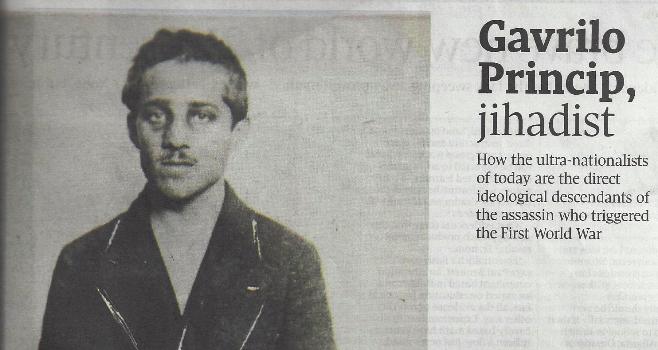
Is 2014,
like 1014, a prelude to world war?
Liệu 2014, như 1914, con chim "báo bão"?
Thằng bé, the boy, làm
thịt Archduke và mở cánh cửa cuộc chiến toàn cầu
[The
Globe and Mail]
Re:
Sarajevo. Archduke Franz là thừa kế của vương quyền đế quốc Áo- Hung.
Cặp vợ chồng
viếng thăm Sarajevo, ngày 28 Tháng Sáu, 1914, chừng 1 giờ sau, thì cả
hai bị thằng
bé sinh viên Princip làm thịt
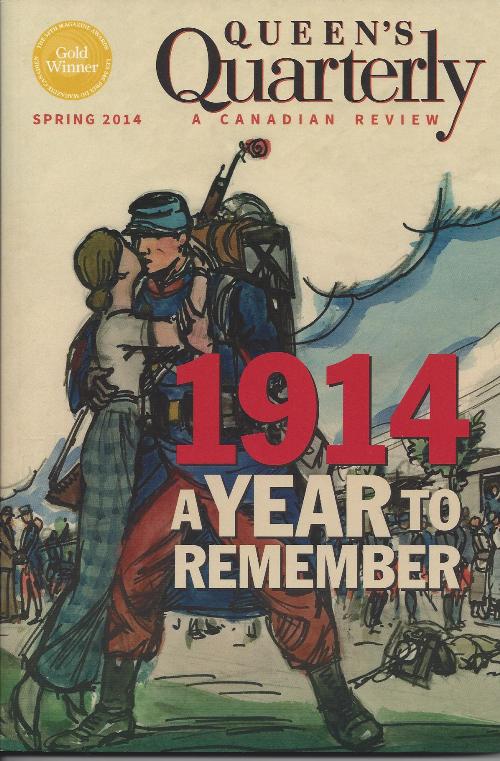
Note: Đây là
đề tài lèm bèm [debate] của tờ nhựt báo Globe and Mail, Toronto, số cuối
tuần, Sat, June, 2014.
Nó làm Gấu
nhớ đến cái chết dởm của mấy tên tù VC, ở trại tù Phú Lợi, mở ra cuộc
chiến Mít
lần thứ nhì, làm chết trên 3 triệu Mít, và làm tiêu luôn nước Mít.
Tuy nhiên,
nó còn làm Gấu nhớ đến bài thơ thần sầu của Auden, được nhà
thơ Mẽo
Robert Hass vinh danh sau đây:
Bài thơ chấm
dứt một ngàn năm [nô lệ thằng Tầu].
Chính là vì,
phải tìm đủ cách ăn cướp Đàng Trong, mà lũ Bắc Kít đã rước họa Tầu Phù
vô “Đàng
Ngoài “ Chúng quên nỗi nhục nô lệ thằng Tầu 1 ngàn năm.
Bi giờ nghe
tụi chúng chống Tẫu, lèm bèm về “thoát Trung”, Gấu thấy tởm, cực tởm!
Tuy nhiên
bài thơ thần sầu này chẳng mắc mớ gì tới ba cái chuyện nhơ bửn đó.
Nó làm GCC nhớ
đến ông nhà thơ, qua những câu, thí dụ như:
A few
thousand will think of this day
Một vài ngàn
năm sau sẽ nghĩ đến ngày này
Mad Ireland
hurt you into poetry
Ái Nhĩ Lan khùng
dùng dao đẩy ông vô thơ
[Việt Nam đói
nghèo quên ca dao]
For poetry
makes nothing happen: it survives.
Thơ làm chẳng
cái gì xẩy ra: nó sống sót…
DECEMBER 27 [1998]
A Poem for the End of a
Thousand
Years:
W.H. Auden
We are about
to enter the last year of the century and-I was going to write-of a
millennium,
but who, in fact, has any sense of the year 999, or for that matter
1132 or
1412? This last century has been more than enough for us to try to take
in. So
I found myself thinking about an appropriate valediction to this last
extraordinarily violent hundred years. Sixty years ago this January, on
the eve
of the Second World War, the Irish poet William Butler Yeats died. A
younger
English poet, W H. Auden, wrote an elegy for him. It's become a very
famous
poem. A winter like this one. The tenth year of an economic depression.
Hitler's military, having annexed Austria and the Sudetenland, is
drawing up
plans for the conquest of Europe. And an Irish poet dies:
In Memory of W B. Yeats
(d. Jan 1939)
I.
He
disappeared in the dead of winter:
The brooks
were frozen, the airports almost deserted,
And snow
disfigured the public statues;
The mercury
sank in the mouth of the dying day.
What
instruments we have agree
The day of
his death was a dark cold day.
Far from his
illness
The wolves
ran on through the evergreen forest,
The peasant
river was un-tempted by the fashionable quays;
By mourning
tongues
The death of
the poet was kept from his poems.
But for him
it was his last afternoon as himself,
An afternoon
of nurses and rumors;
The
provinces of his body revolted,
The squares
of his mind were empty,
Silence
invaded the suburbs,
The current
of his feeling failed; he became his admirers.
Now he is
scattered among a hundred cities
And wholly
given over to unfamiliar affections
To find his
happiness in another kind of wood
And be
punished under a foreign code of conscience.
The words of
a dead man
Are modified
in the guts of the living.
But in the
importance and noise of to-morrow
When the
brokers are roaring like beasts on the floor of the
Bourse,
And the poor
have the sufferings to which they are fairly
accustomed,
And each in
the cell of himself is almost convinced of his freedom,
A few
thousand will think of this day
As one
thinks of a day when one did something slightly unusual.
What
instruments we have agree
The day of
his death was a dark cold day.
II.
You were
silly like us; your gift survived it all:
The parish
of rich women, physical decay,
Yourself. Mad Ireland hurt you into poetry,
Now Ireland
has her madness and her weather still,
For poetry
makes nothing happen: it survives
In the
valley or its making where executives
Would never
to tamper, flows on south
From ranches
of isolation and the busy briefs,
Raw towns
that we believe and die in; it survives,
A way of
happening, a mouth.
III.
Earth,
receive an honored guest:
William
Yeats is laid to rest.
Let the
Irish vessel lie
Emptied of
its poetry.
In the
nightmare of the dark
All the dogs
of Europe bark,
And the
living nations wait,
Each
sequestered in its hate;
Intellectual
disgrace
Stares from
every human face,
And the seas
of pity lie
Locked and
frozen in each eye.
Follow,
poet, follow right
To the
bottom of the night,
With your un-constraining
voice
Still
persuade us to rejoice;
With the
farming of a verse
Make a
vineyard of the curse,
Sing of
human un-success
In a rapture
of distress;
In the
deserts of the heart
Let the
healing fountains start,
In the
prison of his days
Teach the
free man how to praise.
The
Bourse is the name of the French stock
exchange
Happy
New Year
Robert Hass: Now
& Then
|
|

